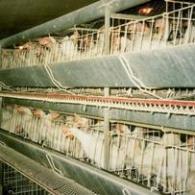The new US trend: the cage-free egg

Apparently, the latest trend in the US food world is the cage-free egg.
Eggs from chickens raised in large, open barns instead of popular battery cages have become the latest addition to menus at universities, hotel chains and cafeterias at huge corporate companies.
This demand, in turn, has resulted in a rush on cage-free eggs, and some big buyers say that there may not be enough to go around.
Years to make the switch
In September 2006, Ben and Jerry’s became the first major food manufacturer to announce it would use only cage-free eggs that have been certified humane by an inspecting organisation. However, the company says it will need four years to complete the switch.
Many chicken farmers are not suddenly changing their cage systems. They also say that they are not convinced the chickens are better off, and that converting requires time, money and faith that the spike in demand is not just a fad.
Is there really a market?
Gene Gregory, president of the United Egg Producers asks whether people are indeed buying cage-free eggs, as they may cost two or three times more in the supermarket.
According to John Brunnquell, owner of Egg Innovations, it takes about six months to build a cage-free operation. The cost for a well-designed facility is about US$30 a bird. Building a conventional operation with the stacks of cages, known as batteries, costs about $8 a bird.
Percentage is steadily rising
A few years ago, about 2% of the 279 million laying hens in the US were not confined to small cages, according to statistics from the United Egg Producers. That figure is now closer to 5%.
Growing consumer concern with farm animal welfare and interest in local and sustainable agriculture have driven some of the popularity, but campaigns by animal rights activists have had a lot to do with it.
“…the edge in food safety”
Officials at Notre Dame turned down a request by a campus animal rights group to switch to cage-free eggs after investigating the issue for six months.
The university, which serves 16,000 meals a day in its dining halls, visited both cage and cage-free operations, examining animal welfare, food safety, environmental impact, taste and other issues. Both operations they toured appeared to take equally good care of their chickens, said Jocie Antonelli, nutrition and safety manager.
The university decided that its current source of eggs, which uses a cage system, had the edge in food safety.
“There are pros and cons to each system,†Antonelli said. “Either way, these are not free-roaming chickens living out in a pasture.â€
“While cage-free certainly does not mean cruelty-free, it’s a significant step in the right direction,†said Paul Shapiro of the Humane Society.
EU’s Directive for battery hens already in place
The European Commission has also adopted a proposal for a new Directive aimed at improving the housing conditions for laying hens. The Directive lays down minimum protection rules for laying hens kept in various forms, including cages. The new requirements would apply to newly built or rebuilt systems from 1 January 1999 and from 1 January 2009 for all housing systems.
Related links:
Related articles:













